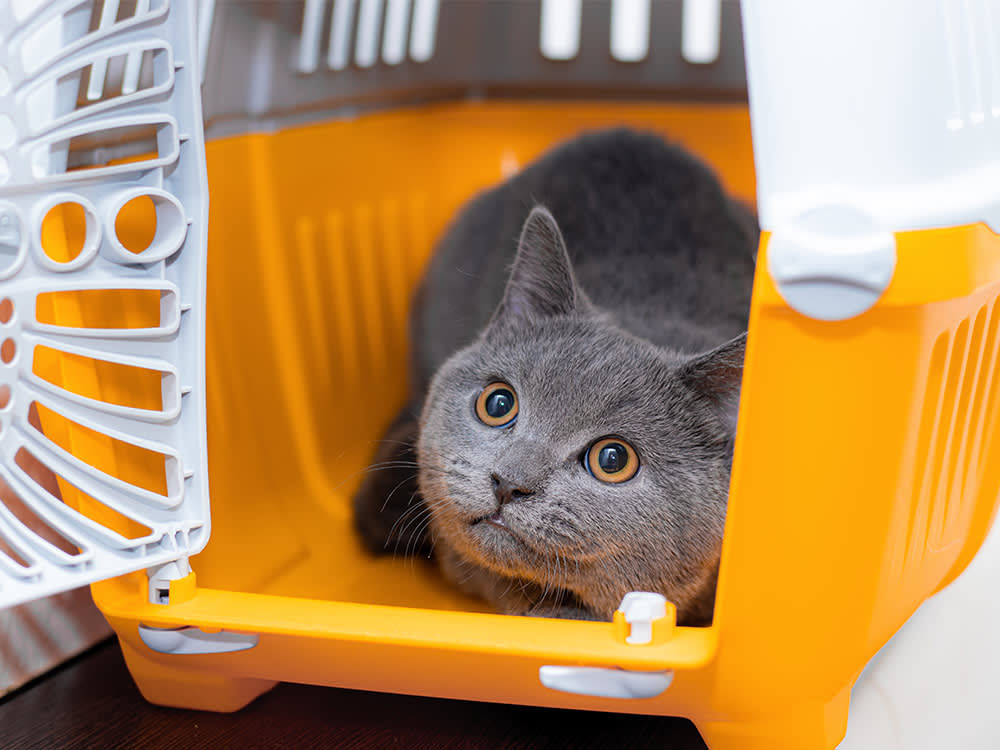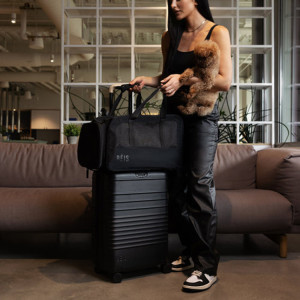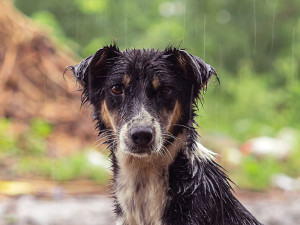How to Prepare Your Pet for a Natural Disaster
The East Coast just had a rare earthquake. A vet breaks down what to include in an emergency go-bag for your pet in times like this.

share article

Your pet wants you to read our newsletter. (Then give them a treat.)
On Friday morning, residents of cities from Philadelphia to Boston experienced something that may have had them checking their calendars to see if it was somehow a repeat of April Fools’ Day: an earthquakeopens in a new tab. The East Coast isn’t exactly known for this kind of natural disaster — you usually have to look to the west for that.
But this morning, people up and down the coast felt the 4.8 magnitude earthquake. It originated about 50 miles west of Manhattan in Lebanon, New Jersey. Residents of all of the five boroughs of New York City felt their buildings shaking; the mayor’s office tweetedopens in a new tab that there is no significant damage but that officials are “still assessing the impact.” Meanwhile, the Empire State Building tweetedopens in a new tab to let everyone know it’s doing just fine.
All jokes aside, this earthquake has made it clear that you never know when you need to prep your home for natural disasters to keep you — and your pet — safe. Disasters like earthquakes, hurricanesopens in a new tab, and wildfires opens in a new tabcall for quick, decisive action that’s almost impossible without a plan. The post-apocalyptic films make it look so easy: a lone survivor with their dog, moving through a wasteland, carrying all that they own on their backs. The reality is less cinematic (but no less scary): crates, toiletries, medication, phone lists...
So, how do you prepare for a hurricane when you have a pet? Ready.govopens in a new tab boils prepping down to three points: Make a plan, build an emergency kit, and stay informed. Here’s how that looks for pet safety, with tips from veterinarian Dr. Gary Richter.
1. Plan to stay and plan to go.
Stay
If you stay, do it safely. Identify a secure area of your home, close off hidden areas where nervous cats may try to hide, and remove toxic or dangerous products from the safe space. If there is an open fireplace, vent, pet door, or similar opening in the house, close it off with plastic sheeting and strong tape. And give a trusted neighbor, friend, or family member a copy of your house key in case you find yourself blocked in — ideally someone your pet knows and trusts.
Go
If your home is unsafe for you, it’s unsafe for your pet. Be prepared to leave before you’re ordered to. And since most American Red Cross shelters cannot accept pets (service animals that assist people with disabilities are allowed) because of health and safety regulations, have a few options for your pet’s temporary housing. The American Humane Society recommends that you flag a few dog-friendly destinations: hotels, homes of friends or family, or kennels outside your immediate area.
2. Build an emergency kit.
This is basically a go-bag for your pet. Dr. Richter recommends these crucial items:
Folding dog crate or cat carrier
Sherpaopens in a new tab’s classic cratesopens in a new tab, dog carriersopens in a new tab, and cat carriersopens in a new tab are soft, foldable, and secure.
Pet food and water
Dr. Richter recommends preparing in advance: “a one-week supply of cat foodopens in a new tab or dog foodopens in a new tab, kept in watertight containers. This is especially important if your pet has specific dietary needs.”
Spare leash, collar and/or harness
“This is really important and really easy to forget,“ Dr. Richter says. “Collars and leashesopens in a new tab can get lost or destroyed, and they are crucial to keeping your pet safe.” Indeed, the last thing you need is to have to scramble after or carry an animal whose leash or collar has gone missing. Whatever happens, you need at least one free hand.
Collapsible bowls
Assume space is limited and you’ll have to carry what you need. Bowls like the ones we recommend in our car-safety gearopens in a new tab article are easy to carry.
Packable bed or blanket
Most plush dog bedsopens in a new tab can be compressed for easy portage. Ideally, have one your dog is already comfortable with.
Medication and flea treatment
Especially important if these are taken daily.
Copy of pet health records and proof of vaccines
Along with your vet’s contact info. Dr. Richter adds: “This is super importantopens in a new tab since all animals tend to have different medical needs.”
Toys, treats, and beloved items
“Be sure to pack an object that your pet responds to and finds comforting,” Dr. Richter says. “I recommend taking a towel with your scent on it, and placing it at the bottom of your pet’s crate.”
Sanitation supplies
From cat litter and a portable litter box to poop bags and dog groomingopens in a new tab wipes, pack whatever you can to keep your pet family clean and healthy on the move.
Your and your pet’s ID
Have proof you belong to your pet. Microchipping your dog or cat is the best way to ensure their long-term safety, especially if you get separated during a disaster. Also make sure they are wearing an ID tag on their collar, plus always keep dogs leashed and cats in carriers during moments of greatest flux.
Finally, it can’t hurt to carry a photo of you with your pet in case records go missing and you find yourself in a situation at a shelter needing to prove ownership. From Dr. Richter: “The truth is, there are a lot of Golden Retrievers out there, and they all look like Golden Retrievers! Microchipping your pet is the best way to prove ownership and help locate them if you’re separated.”
CBD oil or sedatives
CBD tinctures and treats have a natural calming effectopens in a new tab on pets and are perfectly safe. If your pet is high strung in general and you fear they will become a flight risk on the move, ask your vet in advance for sedatives or situational anti-anxiety medication.
Watch this video on how to build a pet disaster kit from The Humane Society:
3. Stay informed.
Local emergency management offices, animal shelters, and animal control departments regularly share pet safety tips as threats play out in emergency situations. Look up the best resources in your town and have their contact info at the ready. Also:
Follow emergency wirelessopens in a new tab alerts for news and updates from local and state officials.
Download the FEMA appopens in a new tab for weather alerts from the National Weather Service for up to five different U.S. locations.
Observe your pets closely after the fact — make sure you’re in control of them around damaged fences, risen waters, or other unstable conditions. Missing scent markers can disorient pets enough that they can’t find their way home on their own. Be aware of nose- or paw-level hazards, such as spilled chemicals, debris, or other disaster aftermath.
|And be patient with any new behavioral problems and consult a vet if they persist (pets can suffer from PTSD, too). The good news is you’ve weathered the storm together. The better news is you’ve grown a bit together.

Chris Norris
Chris Norris is a writer, reporter, author, and longtime companion to West Highland terrier Gus, recently departed but intensely loved. Chris Norris is has written for The New Yorker, New York Magazine, The New York Times Magazine, Rolling Stone, GQ, Details, and NPR’s “All Things Considered.” He lives in New York City with his wife and 10-year-old son.

Hilary Weaver
Hilary Weaver is the senior editor at The Wildest. She has previously been an editor at The Spruce Pets, ELLE, and The Cut. She was a staff writer at Vanity Fair from 2016 to 2019, and her work has been featured in Esquire, Refinery 29, BuzzFeed, Parade, and more. She lives with her herding pups, Georgie and Charlie.
Related articles
![Four dogs standing on a fallen tree surrounded by water from a flood from hurricane Fiona.]() opens in a new tab
opens in a new tabHow to Help Dogs and Cats Affected by Hurricane Fiona
Rescue organizations are in need of donations (and adoptions) after the devastating storm.
![A woman standing next to a suitcase with a dog carrier on top while holding her dog.]() opens in a new tab
opens in a new tabThe Best Dog Carriers For Planes, Trains, and Automobiles
Whether you’re driving cross country or flying internationally, your pup can comfortably tag along.
![anonymous woman pampering and taking care about a small ginger kitten]() opens in a new tab
opens in a new tab6 Ways to Help Local Shelters Without Committing to Full-Time Pet Parenthood
Adoption isn’t for everyone—here are other ways you can be there for animals in need.
![Dog sitting on the ground in the rain]() opens in a new tab
opens in a new tabHow to Help Animals Impacted by Hurricane Ida
Hundreds of dogs, cats, and rabbits have been evacuated. These front-line organizations need donations, fosters, and adopters.
![one white cat in a black carrier next to two other cats looking up]() opens in a new tab
opens in a new tab8 Cat Carriers for a Quiet Ride
It’s the journey, not the destination.
![Cat standing up in the back of a car]() opens in a new tab
opens in a new tabHow to Travel With a Cat (Without a Scratch)
Everything you need to bring your kitty home for the holidays, from an in-cabin carrier to calming products to a portable litter box.





